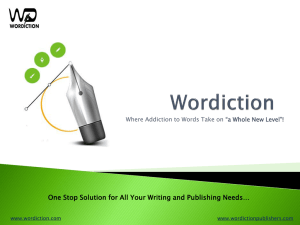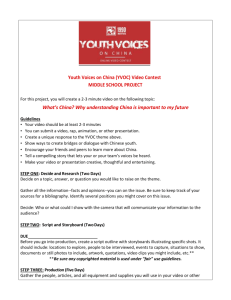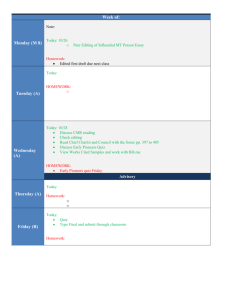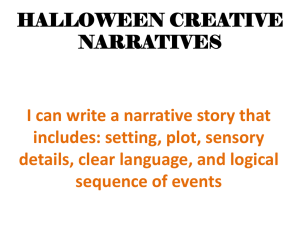1ManipulatingArtistry
advertisement
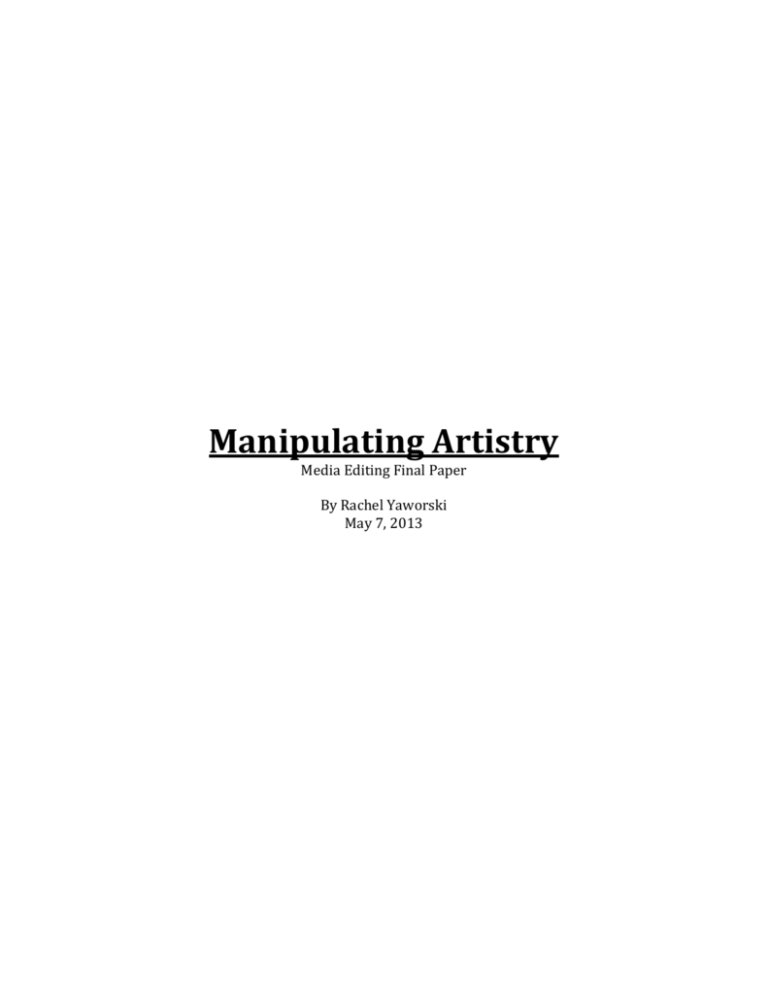
Manipulating Artistry Media Editing Final Paper By Rachel Yaworski May 7, 2013 The presence of media in our society today can be quite overwhelming. It’s everywhere you go. Everywhere you look, you will find yourself looking at television, newspapers, YouTube videos and visual art. It’s very difficult to get through your day without hearing references to Facebook, tumblr, pinterest, Google, or twitter. We live in a very connected and creative time in world history, and our ability to edit media has become in and of itself a form of art. Through my own experiences in and out of this course, I have found that media editing can be defined as the manipulation of media in artistic form, and it is also a practice of personal creative expression. Media editing has certainly become more evident in today’s world, and is much easier for the average person to have access to the tools needed to do it. For example, tools such as Photoshop or iMovie are available to the general public and can be learned relatively quickly. This was not true fifty years ago. However, that does not mean that media editing is a new concept. On the contrary, media editing is a very old concept that has been used throughout history. One only needs to look back as far as the 1940’s. In World War II, propaganda was one of the most powerful tools used to manipulate moral. Whether it was to encourage the folks in the homeland to buy war bonds (http://www.retronaut.com/2013/01/buy-warbonds-posters/), or to encourage the citizens of England who were living through the blitz to “Keep Calm and Carry On” (http://www.guardian.co.uk/lifeandstyle/gallery/2009/mar/17/keep-calm-carryon-pictures), governments used posters, commercials and movies to spread their agenda far and wide. This was not a tactic used solely by the allies either; the Nazi’s were quite well known for their propaganda as well. If one were to go back even further in history, media editing can be seen as far back as ancient Greece, Rome and Egypt. Whether it was paintings, frescos, or ancient statues, these works of art were forms of expression used to convey messages the same way that a person’s cover page on their Facebook page does (although it is usually much easier to identify the embedded message within a cover photo than an ancient statue would). The most important aspects of artistic creations are the way they are presented. This is indeed where the ‘editing’ part of ‘media editing’ comes into play. A statue of a saint, a painting of a soldier, or a mighty Pharaoh’s tomb doesn’t inherently spread a message of it’s own, but it is the way they are presented and, in turn, perceived by the public that creates the message an artist is trying to make. A small statue of a saint in the corner of a room does not make the same statement as a gleaming white, larger-than-life-size statue placed on the roof of St. Peter’s Basilica in Vatican City does (see below). A painting of a soldier can be made ten times more effective in conveying a message if the soldier is young looking, handsome, and the colors used are patriotic (http://thenewzealandjournal.blogspot.com/2010/05/salute-soldier-back-attackworld-war-ii.html) An enormous pyramid that houses and immortalizes the remains of an ancient Pharaoh reminds us of important political leaders of the past. Alternately, even if there has been no editing done to an image, the way it is presented can completely change the way it is perceived by someone. For example, the Kuleshov Effect is a concept based on a video edited by Lev Kuleshov. It is a simple video (http://www.youtube.com/watch?v=_gGl3LJ7vHc) that shows a man’s face intercut with footage of a bowl of soup, a girl in a coffin and a pretty woman lying on a couch. The footage of the man’s face is the same image repeated through out the video, yet a number of people whom viewed the video believed that the man’s expression changed after seeing each of the other images. That is the power of Media Editing. Nothing had changed except for the way the film was edited, and therefore the way it was perceived was completely different. A more current example of media editing in our everyday world could be a look at an issue of Time magazine. After famous football player O.J Simpson was arrested on the charge of murdering his ex-wife and her lover, his mug shot appeared on the cover of Time Magazine with a caption reading “An American Tragedy” (http://www.time.com/time/covers/0,16641,19940627,00.html). The mug shot on the cover had been altered from the original to make Simpson’s skin look darker and (one can assume) more intimidating. The media was edited for the personal gain of the editors of the magazine. Political agendas are easily inserted into the images we see in our everyday life. These kinds of things are what make media editing such a powerful tool. In my own work, I used the assignments given to present my own artistic creativity and vision, rather than push any political agendas I may or may not have. For example, I created a video montage based on the word ‘Beauty’ (http://www.youtube.com/watch?v=v8Y4tXh2IGs). I used a musical piece that I love and placed it behind footage of places I have travelled to give my own interpretation of what I think is beautiful. The footage in the hands of someone else could have been presented in a much different way; however, this was the way I chose to artistically express my thoughts and feelings about the subject. Another example of my own work was the assignment where we had to use two different songs and create a mash-up (https://soundcloud.com/rippen_rayray/2013spyaworski-mashup). I used two songs by Florence and the Machine. Both songs I used have personal meaning to me, so I decided to mix them together. The way the music is then perceived by a listener can be very different from what the original artist had perhaps intended, but I have taken her work and used it to represent my own feelings and memories of when and where I was when listening to these songs. I truly think that the beauty of media editing lies in one’s own creative expression, and that a person’s work can be observed in many different ways to many different people. It is a form of artistry and creative expression. It affects the way we think and feel about things. It can make us laugh, and it can make us cry. It can stir feelings of patriotism, or feelings of hatred. The way we edit media can express our political views, or even just state a simple opinion about what we find beautiful in the world. It connects us all to each other, whether it is through our edited profiles on our Facebook pages, or simply admiring a work of art made hundreds of years ago. Media editing is a form of art and expression. It is the way we tell our stories and can determine how future generations will see how we lived our lives, and what was important to us. Media editing is how we perceive the world, and how we would like to share our values and ideals with others. Most importantly, I find that media editing is more than just manipulation, but the preservation of our artistry and a way to share our creativity with the world.


